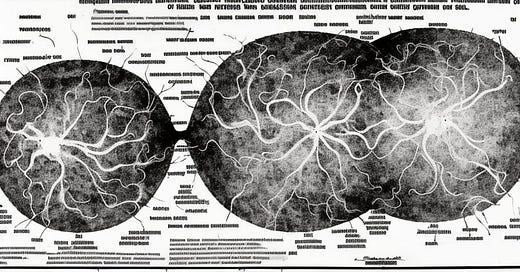Dear reader, my intention with this substack is to produce in public a coherent book on petrohistory, but what you’re getting here is far from the fully realized work. To support this project, buy a paid subscription now, and I’ll send you a “free” copy of the book in a few years, when it’s ready. It will be better than the below.
(2)
There’s long been a very strong, racist tendency in the liberal environmentalist movement to blame ecological harm on the number of human bodies that exist. They want us to believe that earth’s degradation would cease if there were fewer people available to consume the fruits of industry and especially agriculture (which is where we get into nitrogen’s domain). We’re exposed to white men who rant about the “population explosion,” or the “population bomb,” phrases which draw easy but still potent double-meanings in the context of nitrogen. Obviously, these writers are stooges of the regime, pushing our discourse away from the real issues. They should be systematically ignored.
Yes, the total number of humans that exist at any one time has increased over the time of the reign of the dead god, and that’s not a coincidence or accident. But animal bodies, whether human or bovine or chicken, can create only so much ecological damage on their own: pre-industrially, they created none, as the ecosystem re-absorbed the ammonia from their shits. What matters is the subjecting of bodies, not just bovine but also chicken and fish and human, to ecological shortcuts and industrial expediencies of scale that arise from the capitalist imperative. What matters most of all is the amount and type of exosomatic energy that is applied to the means of production. What matters is energy in calories and kilowatt-hours. That’s what mattered when all energy was labor, and still matters today in the exosomatic regime.
It’s important to remind ourselves of scale, for which we can use Buckminster Fuller’s concept of “energy slaves.” Somewhere after Fuller, an energy slave was defined to be the energetic equivalent to a human working 24 hours a day, 365 days a year. In fact, Fuller adopted the less-stupid standard of a healthy individual working 40 hours per week. That amounts to 3 kilowatt-hours (kWh) per week—it did then, and it does now; human bodies have not changed all that much. The American oil industry produces about 9 billion kWh per week, or about 3 billion energy slaves. (Never count consumption; always count production.) There’s no reason to divide that up per capita, since it’s the oil industry and not citizens producing all that energy. But if you did, it would work out to nine energy slaves for every human body, just from oil, not counting coal and gas. Unlike living bodies, these energy slaves are actually jinn that live within pollutant molecules and that bring pestilence upon our cities in one form or another.
Nonetheless, the population has increased, and that is because coal oil and gas could be mobilized to synthesize ammonia (NH3) without organic input, which is why this precedes an essay about Nitrogen.




Interesting. It is also interesting that the per capita analysis does show that the elite white men who own the means of production themselves use the most energy and produce 25% of carbon emission and damage.I look foreword to understanding more about nitrogen.
Yes, that's a really fine essay, thrilling to read. But to just to position myself, I define myself as a macrofutilist, so I'm also always saddened by those still thinking that they are fighting the "class war," like the Japanese army loners who hid out in caves fighting World War II when it long been officially declared over.
There isn't a class war - it's been a class slaughter for at least five decades in the US, with all the institutions fully aligned with the rules of petrochemical finance capital.
How can "environmentalism" be a movement when it isn't even capable of being defined in material reality? What could constitute a environmental program when oil is the blood in our ultrasocial veins?
Humans should never have allowed themselves the use of fire, but here we are, generation after generation of mounting ungovernability presaging self-induced, yeast in a vat extinction.
Yes, we can draw up an ancestral imaginary that places our precursors in halcyon epochs of balance and ecological humility, but they are all dead, nothing that is dead can be retrieved into life, and we living humans are governed by ineluctable imperatives to keep and find and produce and use.